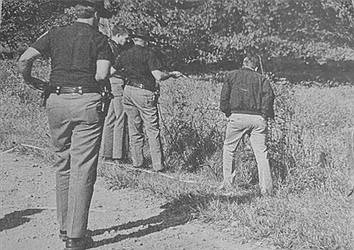Hoosier Solar denied after long, tense hearing
July 19, 2023 at 4:42 p.m.

There was a hearty standing ovation at the Princess Theatre last Wednesday evening and it had nothing to do with any theatrical performance. But if the Rush County Board of Zoning Appeals had taken a curtain call, no one would’ve blinked.
Because after almost four hours of listening to public comments from a packed house and then deliberating carefully, the board denied the first of three applications from South Bend-based Hoosier Solar to begin operations in the county. Then Colin Kelly, vice-president of development for the initiative, asked permission to address the board and announced that based on that first vote Hoosier Solar would withdraw its other two similar petitions. This set off cheers and claps around the hall.
The proceedings appeared to be right out of a courtroom as the Naylors and several other private landowners had hired Jason Kuchmay (Snyder, Morgan and Kuchmay, Fort Wayne) and Hoosier Solar had local representation in the form of Grant Reeves, Barada Law Offices; guiding much of the discussion was the board attorney, Geoff Wesling, and Rush County’s attorney Leigh Morning also provided input. Members of the audience came one by one to the podium with mostly remonstrances and Solar was given a chance at rebuttal following these and preceding the board’s vote.
Hoosier Solar had a total of three petitions on the table –two projects covering 10 megawatts each and a much larger project of 184 MW near Glenwood and extending into Fayette County – with the same primary requests attached. One was obtaining a variance for the county’s basic financial assurance contained in the zoning code and second was a combination of approval of a decommissioning plan as well as a special exception as required by the county’s solar ordinance to allow development of the solar energy systems. The firm had already committed to liability insurance of $2 million per occurrence and $5 million aggregate.
The firm (a venture between Inovateus Solar, Advantage Capital and Energy Systems Network), as Kelly and community/government affairs specialist Nick Barbknecht conveyed, had worked with the county the past year in submitting all required applications and relevant studies as laid out in the solar ordinance.
With the Bellflower solar project already in place on the north end of the county, Hoosier Solar sensed an opening for its proposals. Next was a matter of attaining lease agreements with landowners in the focus areas and designing accordingly, which the company did. Had last week’s meeting gone in its favor, the firm would’ve gone ahead with a site plan, location permit and planned operations starting in March 2026.
But the anti-solar crowd ultimately won the day, meaning Hoosier Solar must go back to the drawing board if alternative energy production is still desired in the county. “We like to go where we can work in partnership with the community,”said Kelly. “The way certain things were done here weren’t ideal. We respect the decision and need to go back and improve.”
After a general overview of the company’s intentions, project manager Andrew Hinckley read and submitted a letter of support from former commissioner Paul Wilkinson. Specifically for the plot at 1396 E. State Road 44, owned by the county, Wilkinson was behind the economic impact solar could have on the community’s limited tax base. Stating he resides within a mile from the Bellflower site, Wilkinson wrote his quality of life hasn’t been diminished. “The benefits far outweigh the concerns; we have to capitalize on these projects that come our way,”Hinckley read aloud.
Starting with Kuchmay’s ordered list of concerns, however, 17 local people spoke against the special exceptions (plus a letter of non-support sent to the area plan director) to just two speaking in favor –those were out-of-county Indiana residents.
Kuchmay pointed out commercial solar operations weren’t even a permitted use in the county, and he said, “with good reason.” He said zoning codes require BZA to deny special exceptions that are not in harmony with the purpose and intent of ordinances. In accordance with the county’s comprehensive plan, he went on, there were mandates to preserve property values and promote public health, safety and general welfare; additionally, development was meant to preserve prime farmland and maintain a rural character.
He had included pictures from other solar sites around Indiana that showed flooding and removal of topsoil by heavy equipment. Saying the projects would remove close to 1,300 acres of productive farmland –Hoosier Solar countered it was just .5% of available farm acreage –Kuchmay added “if you live near this, list your home for sale and nobody makes an offer, you better believe that’s a negative impact.”
Other claims by the attorney seemed to have swayed the board based on the resulting vote.
He said no solar project has been decommissioned to date, meaning that is an open-ended concern. He added a small portion of the projects was located on land zoned for RS (single-family residential), which didn’t allow solar per the county code. Kuchmay also said Hoosier Solar didn’t meet requirements for a “development standard variance”as specified in state and local ordinances. As to this, he said the firm effectively was asking to “change the law”and BZA had no authority to do so.
Nick Thomas, owner of Falmouth Farm Supply, spoke candidly in pleading that the board see the gravity of its decision. He employs 50 people at his grain elevator and noted most of the folks in the room have been his customers. Thomas said he’s looking at a $16 million expansion, but his family business would essentially be “valueless”if solar gains a foothold in the area.
“I wasn’t intending to ask for a tax abatement, but you bet your ass I will now if you approve theirs,”he said, bringing a raucous ovation.
Jim Naylor said he’s resided on Orange Pike for 67 years where he and wife Linda raised their children and grandchildren. He knows “every inch”of the 500 acres to his north that was part of the proposal and knows where “every bit of water goes.”Naylor said runoff could adversely affect several tributaries in the area.
Drainage, lack of retention ponds, little money going back to the school system, road deterioration, minimal job creation, energy being shipped out of the county and potential health concerns were some of the other issues raised.
Kuchmay returned to quote directly from the county’s comprehensive plan: “…a very important concept to grasp is agriculture is land use and not vacant ground waiting to be developed; it’s currently at its highest and best use.”
Reeves argued against the claims of his client “changing the law”when it came to development standard variances while acknowledging there was ambiguity in the language of these ordinances. As to the question of RS zoning, Reeves saw this as not being separate from R1, which does permit solar.The board asked Kelly to address a few of the public’s concerns on drainage, aesthetics and runoff retention.
The BZA members then clarified some points with Wesling. The attorney told them the RS zoning exception was a very small, though not insignificant, component of the solar petitions. In his opinion, though, the development standard question was “great lawyering”; he’d need to do further case law research to give the board a definitive answer.
Justin Orme, sworn in as a new member at the start of the night, was first to voice his thoughts. He said he personally diversifies his crop and grain operations and felt strongly that land is indeed in its highest use as agriculture. However, his opinion was that any economic development in the county was bound to take away tillable farm ground; there were vocal disagreements from the crowd on this statement.
Then pivoting back to his first impression, he said “What I’m telling you is that I will never say there can never be anything but corn and soybeans on our farms and it’s prudent to look at opportunities …but in this case, I do not think (solar) is best use of farm ground.”
Wesling said the board could either continue the public hearing at another time, grant the (first) application or deny it.
Member Dohn Green wanted to meet in executive session but was told by Wesling the BZA doesn’t have the ability to speak in private. Another question was whether all agreements were in order for the petition to proceed. Morning replied there was one small change to be negotiated on the economic development agreement between Hoosier Solar and the county. She later added commissioners were to decide on the decommissioning plan July 31 but said the Bellflower project was approved using that same order of events.
President Sandra Jackson finally called for a motion. Vice-president Virgil Bremer moved to approve the financial assurance variance; this died for lack of a second, to the public’s delight. Orme moved to deny the financial exception. After a long pause, Green seconded and applause rang out. Wesling confirmed that Hoosier Solar was asking for a letter of credit or performance bond in lieu of the county’s requirement for cash in escrow. Motion passed 4-1 with Bremer opposed.
Jackson then asked for a motion on decommission and special exception. After brief discussion on decommissioning, Orme moved to deny both; another lengthy pause ensued with murmurs urging the board to second it. Green got a point of clarification from Wesling, then quickly seconded. Motion passed 3-2 with Bremer and Mark Webb opposed.
Hoosier Solar’s investment of over $200 million would have been second only to Diamond Pet Foods in the county’s history. Estimated economic impact was given as $514 million over the life of the projects.
In one other vote, Howard and Jennifer Boland were granted a rezone for their home at 7052 E. County Road 250 North to be converted into a vacation rental.
Latest News
E-Editions
Events
There was a hearty standing ovation at the Princess Theatre last Wednesday evening and it had nothing to do with any theatrical performance. But if the Rush County Board of Zoning Appeals had taken a curtain call, no one would’ve blinked.
Because after almost four hours of listening to public comments from a packed house and then deliberating carefully, the board denied the first of three applications from South Bend-based Hoosier Solar to begin operations in the county. Then Colin Kelly, vice-president of development for the initiative, asked permission to address the board and announced that based on that first vote Hoosier Solar would withdraw its other two similar petitions. This set off cheers and claps around the hall.
The proceedings appeared to be right out of a courtroom as the Naylors and several other private landowners had hired Jason Kuchmay (Snyder, Morgan and Kuchmay, Fort Wayne) and Hoosier Solar had local representation in the form of Grant Reeves, Barada Law Offices; guiding much of the discussion was the board attorney, Geoff Wesling, and Rush County’s attorney Leigh Morning also provided input. Members of the audience came one by one to the podium with mostly remonstrances and Solar was given a chance at rebuttal following these and preceding the board’s vote.
Hoosier Solar had a total of three petitions on the table –two projects covering 10 megawatts each and a much larger project of 184 MW near Glenwood and extending into Fayette County – with the same primary requests attached. One was obtaining a variance for the county’s basic financial assurance contained in the zoning code and second was a combination of approval of a decommissioning plan as well as a special exception as required by the county’s solar ordinance to allow development of the solar energy systems. The firm had already committed to liability insurance of $2 million per occurrence and $5 million aggregate.
The firm (a venture between Inovateus Solar, Advantage Capital and Energy Systems Network), as Kelly and community/government affairs specialist Nick Barbknecht conveyed, had worked with the county the past year in submitting all required applications and relevant studies as laid out in the solar ordinance.
With the Bellflower solar project already in place on the north end of the county, Hoosier Solar sensed an opening for its proposals. Next was a matter of attaining lease agreements with landowners in the focus areas and designing accordingly, which the company did. Had last week’s meeting gone in its favor, the firm would’ve gone ahead with a site plan, location permit and planned operations starting in March 2026.
But the anti-solar crowd ultimately won the day, meaning Hoosier Solar must go back to the drawing board if alternative energy production is still desired in the county. “We like to go where we can work in partnership with the community,”said Kelly. “The way certain things were done here weren’t ideal. We respect the decision and need to go back and improve.”
After a general overview of the company’s intentions, project manager Andrew Hinckley read and submitted a letter of support from former commissioner Paul Wilkinson. Specifically for the plot at 1396 E. State Road 44, owned by the county, Wilkinson was behind the economic impact solar could have on the community’s limited tax base. Stating he resides within a mile from the Bellflower site, Wilkinson wrote his quality of life hasn’t been diminished. “The benefits far outweigh the concerns; we have to capitalize on these projects that come our way,”Hinckley read aloud.
Starting with Kuchmay’s ordered list of concerns, however, 17 local people spoke against the special exceptions (plus a letter of non-support sent to the area plan director) to just two speaking in favor –those were out-of-county Indiana residents.
Kuchmay pointed out commercial solar operations weren’t even a permitted use in the county, and he said, “with good reason.” He said zoning codes require BZA to deny special exceptions that are not in harmony with the purpose and intent of ordinances. In accordance with the county’s comprehensive plan, he went on, there were mandates to preserve property values and promote public health, safety and general welfare; additionally, development was meant to preserve prime farmland and maintain a rural character.
He had included pictures from other solar sites around Indiana that showed flooding and removal of topsoil by heavy equipment. Saying the projects would remove close to 1,300 acres of productive farmland –Hoosier Solar countered it was just .5% of available farm acreage –Kuchmay added “if you live near this, list your home for sale and nobody makes an offer, you better believe that’s a negative impact.”
Other claims by the attorney seemed to have swayed the board based on the resulting vote.
He said no solar project has been decommissioned to date, meaning that is an open-ended concern. He added a small portion of the projects was located on land zoned for RS (single-family residential), which didn’t allow solar per the county code. Kuchmay also said Hoosier Solar didn’t meet requirements for a “development standard variance”as specified in state and local ordinances. As to this, he said the firm effectively was asking to “change the law”and BZA had no authority to do so.
Nick Thomas, owner of Falmouth Farm Supply, spoke candidly in pleading that the board see the gravity of its decision. He employs 50 people at his grain elevator and noted most of the folks in the room have been his customers. Thomas said he’s looking at a $16 million expansion, but his family business would essentially be “valueless”if solar gains a foothold in the area.
“I wasn’t intending to ask for a tax abatement, but you bet your ass I will now if you approve theirs,”he said, bringing a raucous ovation.
Jim Naylor said he’s resided on Orange Pike for 67 years where he and wife Linda raised their children and grandchildren. He knows “every inch”of the 500 acres to his north that was part of the proposal and knows where “every bit of water goes.”Naylor said runoff could adversely affect several tributaries in the area.
Drainage, lack of retention ponds, little money going back to the school system, road deterioration, minimal job creation, energy being shipped out of the county and potential health concerns were some of the other issues raised.
Kuchmay returned to quote directly from the county’s comprehensive plan: “…a very important concept to grasp is agriculture is land use and not vacant ground waiting to be developed; it’s currently at its highest and best use.”
Reeves argued against the claims of his client “changing the law”when it came to development standard variances while acknowledging there was ambiguity in the language of these ordinances. As to the question of RS zoning, Reeves saw this as not being separate from R1, which does permit solar.The board asked Kelly to address a few of the public’s concerns on drainage, aesthetics and runoff retention.
The BZA members then clarified some points with Wesling. The attorney told them the RS zoning exception was a very small, though not insignificant, component of the solar petitions. In his opinion, though, the development standard question was “great lawyering”; he’d need to do further case law research to give the board a definitive answer.
Justin Orme, sworn in as a new member at the start of the night, was first to voice his thoughts. He said he personally diversifies his crop and grain operations and felt strongly that land is indeed in its highest use as agriculture. However, his opinion was that any economic development in the county was bound to take away tillable farm ground; there were vocal disagreements from the crowd on this statement.
Then pivoting back to his first impression, he said “What I’m telling you is that I will never say there can never be anything but corn and soybeans on our farms and it’s prudent to look at opportunities …but in this case, I do not think (solar) is best use of farm ground.”
Wesling said the board could either continue the public hearing at another time, grant the (first) application or deny it.
Member Dohn Green wanted to meet in executive session but was told by Wesling the BZA doesn’t have the ability to speak in private. Another question was whether all agreements were in order for the petition to proceed. Morning replied there was one small change to be negotiated on the economic development agreement between Hoosier Solar and the county. She later added commissioners were to decide on the decommissioning plan July 31 but said the Bellflower project was approved using that same order of events.
President Sandra Jackson finally called for a motion. Vice-president Virgil Bremer moved to approve the financial assurance variance; this died for lack of a second, to the public’s delight. Orme moved to deny the financial exception. After a long pause, Green seconded and applause rang out. Wesling confirmed that Hoosier Solar was asking for a letter of credit or performance bond in lieu of the county’s requirement for cash in escrow. Motion passed 4-1 with Bremer opposed.
Jackson then asked for a motion on decommission and special exception. After brief discussion on decommissioning, Orme moved to deny both; another lengthy pause ensued with murmurs urging the board to second it. Green got a point of clarification from Wesling, then quickly seconded. Motion passed 3-2 with Bremer and Mark Webb opposed.
Hoosier Solar’s investment of over $200 million would have been second only to Diamond Pet Foods in the county’s history. Estimated economic impact was given as $514 million over the life of the projects.
In one other vote, Howard and Jennifer Boland were granted a rezone for their home at 7052 E. County Road 250 North to be converted into a vacation rental.





